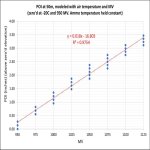Part 1:
Introduction:
I am interested in how the outside air temperature (and therefore its density and air resistance properties), variability affects bullet speed and drop (vertical POI), across a range of muzzle velocities.
I shoot benchrest rimfire at 50m all winter at my local range where we are fortunate to have a heated shooting house, from which we shoot outdoors through window ports for each bench. Over a year we might shoot a range of temperatures between about -35C to +30C. Therefore, the air resistance properties should, in theory, be significant for POI shifts on target across these wide temperature ranges.
Methods:
To investigate this, I used JBM Ballistics program (free online version) to run some theoretical scenarios with 2 independent variables of MV and air temperature.
To calculate the absolute drop, I recorded JBM's output for "time of flight" to 50m for each MV and air temperature scenario combination. Time of flight squared, multiplied by the Gravitational Constant (9.8m/s/s), provides the absolute drop over 50m.
Note: There are no barrel harmonics variables in this model. We are simply isolating air temperature and MV in the model for investigation.
Inputs for the JBM Ballistics scenarios: (note: all of these are held constant, so they should not matter for comparing the differences or delta absolute drop’s):
Cartridge and Bullet: 40 gr, chosen from JBM's library list: It looks to be an old list, and I could not find the current Lapua, Eley and SK lines of ammo I use. So, I just picked one that looked close: Lapua "Midas M". I don't know this line of ammo. But it should not matter anyways, since the bullet's inputs (BC, length) are held constant.
Pressure: Set to 985 mb. (average for my home range).
Altitude: 1000 ft.
Relative humidity: 50%
Twist: 1:16
If this works, I was hoping that I could generate a linear graph of variance, fit a regression line to it with Excel, and then I would have an equation that we could compare to observed real data using a chronograph and weather meter.
Part 2 next shows the modeled results with data and graphs.
Introduction:
I am interested in how the outside air temperature (and therefore its density and air resistance properties), variability affects bullet speed and drop (vertical POI), across a range of muzzle velocities.
I shoot benchrest rimfire at 50m all winter at my local range where we are fortunate to have a heated shooting house, from which we shoot outdoors through window ports for each bench. Over a year we might shoot a range of temperatures between about -35C to +30C. Therefore, the air resistance properties should, in theory, be significant for POI shifts on target across these wide temperature ranges.
Methods:
To investigate this, I used JBM Ballistics program (free online version) to run some theoretical scenarios with 2 independent variables of MV and air temperature.
To calculate the absolute drop, I recorded JBM's output for "time of flight" to 50m for each MV and air temperature scenario combination. Time of flight squared, multiplied by the Gravitational Constant (9.8m/s/s), provides the absolute drop over 50m.
Note: There are no barrel harmonics variables in this model. We are simply isolating air temperature and MV in the model for investigation.
Inputs for the JBM Ballistics scenarios: (note: all of these are held constant, so they should not matter for comparing the differences or delta absolute drop’s):
Cartridge and Bullet: 40 gr, chosen from JBM's library list: It looks to be an old list, and I could not find the current Lapua, Eley and SK lines of ammo I use. So, I just picked one that looked close: Lapua "Midas M". I don't know this line of ammo. But it should not matter anyways, since the bullet's inputs (BC, length) are held constant.
Pressure: Set to 985 mb. (average for my home range).
Altitude: 1000 ft.
Relative humidity: 50%
Twist: 1:16
If this works, I was hoping that I could generate a linear graph of variance, fit a regression line to it with Excel, and then I would have an equation that we could compare to observed real data using a chronograph and weather meter.
Part 2 next shows the modeled results with data and graphs.













































































